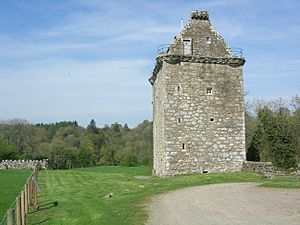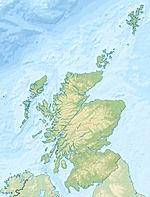Gilnockie Tower facts for kids
Quick facts for kids Gilnockie Tower |
|
|---|---|
| Hollows, near Canonbie, Dumfries and Galloway, Scotland UK |
|

Gilnockie Tower, viewed from the south.
|
|
| Coordinates | 55°05′51″N 2°58′04″W / 55.097461°N 2.967777°W |
| Type | Oblong plan Tower house |
| Height | 38 feet (parapet); 44 feet (beacon of south gable) |
| Site information | |
| Owner | Clan Armstrong Centre - Scottish Registered Charity |
| Open to the public |
Yes |
| Condition | Restored 2014–18 |
| Site history | |
| Materials | Cream sandstone |
Gilnockie Tower is a historic stone building, known as a tower house, built in the 1500s. You can find it in a small area called Hollows, about 2.3 kilometers north of Canonbie, in the south-west of Scotland. The tower sits right on the west bank of the River Esk. When it was first built, it was actually called Hollows Tower.
It's important to know that Gilnockie Castle is a different historical site nearby, not the same as Gilnockie Tower.
Contents
History of Gilnockie Tower
The name Gilnockie comes from the Scottish Gaelic words Geal Cnocan, which mean 'Little White Hill'. Gilnockie Tower was built around 1520 by a famous Border outlaw named Johnnie Armstrong. He was the younger brother of Thomas Armstrong of Mangerton.
In 1528, the tower was burned by Sir Christopher Dacre, who was an English leader in the borderlands. Then, in 1530, Johnnie Armstrong and 50 of his followers were captured and executed by King James V. This happened after they were tricked into joining what they thought was a hunting party. This sad event is even remembered in an old song called "Johnnie Armstrong".
The tower was rebuilt after being burned, but it was damaged again by English attacks in the 1540s. Even so, it was rebuilt once more! This time, it got a new walkway at the top (called a parapet walk) and a special spot for a beacon light on the roof.
Restoring the Tower
By 1978, Gilnockie Tower was just a ruin with no roof. A man named Major T.C.R. Armstrong-Wilson bought it and decided to restore it completely. A new roof was put on, and new floors were built on all four levels. Real oak doors were added to every room. The inside walls were plastered, and electricity and water were brought into the building.
Gilnockie Tower is a very important historical site, officially recognized as a Category A listed building. All the restoration work was done carefully with advice from the Scottish Development Department, which helps protect ancient monuments.
In January 2015, the tower closed for even more major repairs. The goal was to make the building look as much like it did in the 1500s as possible. They also made sure it was safe for visitors today. These repairs finished in 2018. On April 1, 2018, Gilnockie Tower and the Clan Armstrong Centre opened to the public.
Today, the building looks like an authentic home for a clan leader, with a furnished main hall and a master bedroom. The tower also has the Clan Armstrong Museum, which used to be in Langholm. You can see many old items related to the Armstrong family. There's even a special part dedicated to Neil Alden Armstrong, who was the first person to walk on the Moon!
In 2019, Gilnockie Tower received a 4-star rating from Visit Scotland, which means it's a great place to visit. It's known around the world as the original home of the Armstrong Clan.
Exploring Gilnockie Tower
Gilnockie Tower is a simple stone building made of rough stones. It has four main floors plus an attic space. The base of the tower measures about 10 meters by 7.6 meters.
The lowest part of the tower is a cellar with a curved stone ceiling. This cellar has small openings, called gun loops, on the south, west, and north sides, which were used for defense. A spiral staircase in the south-west corner leads up to the first floor, which was used as a large hall. Above this hall are two more rooms, with the attic space above them.
At the very top of the walls, you can see stone supports called corbels. These show where a walkway, called a parapet walk, used to be. During the repairs from 2015 to 2018, this walkway was made safe for visitors, including adding a safety fence. A special feature is the beacon stance, which sticks out from the south end of the roof at the highest point. This was likely used to light a signal fire.
The oldest part of the tower might be a large stone near the basement doorway. This stone has carvings of spirals and a key-like symbol. Experts believe these carvings are from around 2000 BC, meaning the stone was reused when the tower was built.
Gilnockie Castle Site
The place now called Gilnockie Castle is close to Canonbie, at the east end of Gilnockie Bridge. This bridge crosses the River Esk in Hollows, just 500 meters south-east of Gilnockie Tower. Today, only an earthwork (a mound of earth) remains there. It's not completely clear if a stone tower ever stood on this exact spot, though it's possible that an earlier tower, destroyed in 1528, was located here. This site is also connected to Johnnie Armstrong, who was known as the Laird of Gilnockie.



